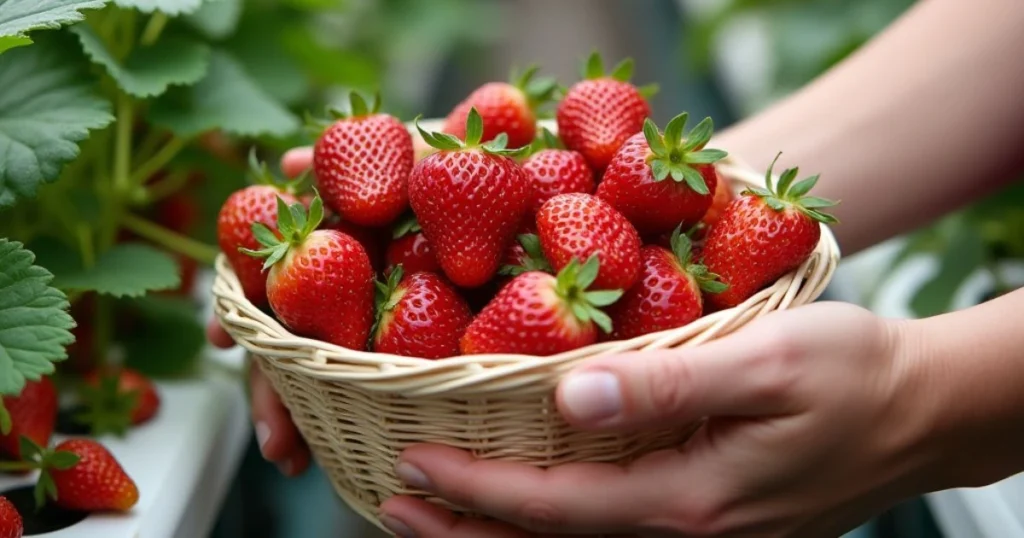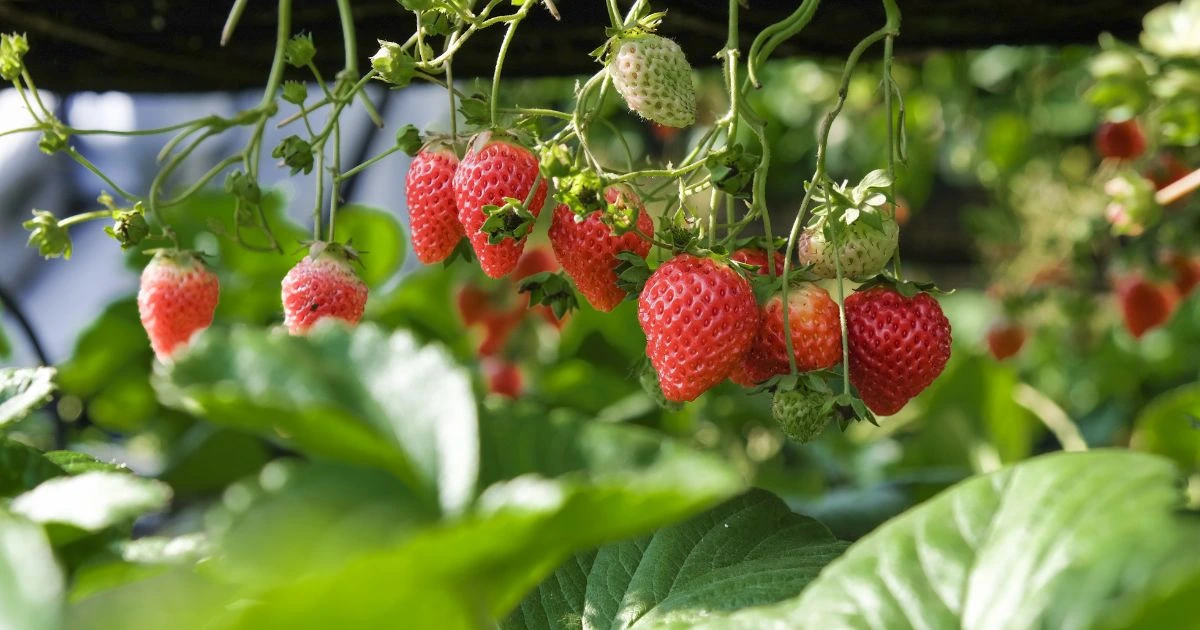Hydroponics is revolutionizing how we grow plants, offering a sustainable and efficient alternative to traditional soil farming. This article focuses on growing strawberries hydroponically—a method that combines technology and nature for an abundant harvest of juicy, flavorful berries. Whether you’re a hobbyist or a serious gardener, this guide will help you understand and master the art of hydroponic strawberries.
Table of Contents
What Are Hydroponics Strawberries?
Defining Hydroponics
Hydroponics is a soil-free method of growing plants where nutrient-rich water delivers essential minerals directly to the roots. This setup eliminates soil-related challenges like inconsistent quality, pests, and diseases, giving you full control over the growing environment.
For strawberries, hydroponics offers numerous advantages:
- Precision Farming: Nutrients and water are carefully controlled, ensuring optimal growth.
- Faster Growth Cycles: Plants grow quicker due to efficient nutrient delivery.
- Clean and Efficient: Without soil, there’s no risk of weeds or soilborne diseases.
This method is perfect for home gardening and commercial farming, particularly in urban areas or regions with poor soil conditions.
Why Choose Hydroponics for Strawberries?
1. Controlled Environment
With hydroponics, you can control temperature, humidity, and light, ensuring strawberries thrive year-round. Unlike traditional methods, you don’t have to worry about adverse weather conditions.
2. Consistent Quality
Hydroponic strawberries are uniform in size, flavor, and color because they receive the same nutrients throughout their growth.
3. Fewer Challenges
- No Soil Pests: Common pests like nematodes or soil fungi are eliminated.
- No Weeds: Spend less time maintaining your garden.
- Fewer Chemicals: Pesticides and herbicides are rarely needed, making hydroponics safer for you and the environment.
Key Components of a Hydroponic System for Strawberries
To grow strawberries hydroponically, you’ll need a setup that includes the following:
1. Water Reservoir
The reservoir holds the nutrient solution. Ensure it’s made of food-grade material to avoid contamination. Choose a size that matches your system’s needs.
2. Nutrient Solution
This solution supplies essential elements like nitrogen (for foliage growth), phosphorus (for flowering and fruiting), and potassium (for overall plant health). You may also need micronutrients like magnesium, calcium, and iron.
3. Growing Medium
Instead of soil, hydroponics uses materials that anchor plant roots and provide aeration. Popular options include:
- Coconut Coir: Sustainable and retains moisture well.
- Perlite: Lightweight with excellent drainage.
- Rockwool: A fibrous material offering stability and aeration.
4. Lighting System
If you’re growing strawberries indoors, LED grow lights simulate sunlight. Choose full-spectrum LEDs for balanced light, which supports all growth stages.
5. Environmental Controls
Maintaining the ideal temperature (15–24°C or 59–75°F) and humidity (60–70%) ensures healthy plants. Use thermostats and hygrometers to monitor and adjust these factors.
Benefits of Growing Strawberries Hydroponically
1. Enhanced Yield and Quality
Hydroponic systems optimize conditions for strawberry plants, resulting in higher yields and better-quality fruit. Since nutrients are readily available, plants grow faster and produce sweeter, juicier berries.
2. Sustainability and Resource Efficiency
Hydroponics minimizes resource use:
- Water Conservation: Closed systems recycle water, reducing consumption by up to 90%.
- Land Use: Even small spaces can accommodate high-yield systems.
- Reduced Carbon Footprint: Local production cuts transportation-related emissions.
3. Space-Saving Gardening
Hydroponics allows vertical stacking of plants, maximizing output in limited spaces. This makes it ideal for urban dwellers or anyone with limited gardening space.
Basics of Getting Started with Hydroponics Strawberries
1. Setting Up Your Hydroponic System
There are several types of systems suitable for strawberries:
- Nutrient Film Technique (NFT): Plants grow in channels with a thin film of nutrient solution flowing past the roots. Ideal for compact setups.
- Drip Systems: Nutrient-rich water is dripped directly onto each plant’s base, conserving water.
- Deep Water Culture (DWC): Plants float on oxygenated, nutrient-rich water. This system is simple and beginner-friendly.
Start small with a DIY kit or pre-built system to gain experience before scaling up.
2. Selecting the Best Strawberry Varieties for Hydroponics
Not all strawberry varieties are suitable for hydroponics. Opt for day-neutral varieties because they produce fruit continuously under the right conditions. Popular choices include:
- Albion: Known for large, sweet, and firm berries.
- Seascape: A high-yielding variety with excellent disease resistance.
These varieties are reliable, making them ideal for beginners.
3. Nutrition and Maintenance Tips
Maintaining hydroponic strawberries involves monitoring key factors:
- Nutrients: Use a balanced nutrient mix designed for fruiting plants. Adjust ratios as plants move from growth to flowering stages.
- pH Levels: Keep the solution’s pH between 5.5 and 6.5 to avoid nutrient lockout.
- Water Quality: Use filtered or distilled water to prevent mineral buildup.
Keep an eye out for signs of deficiencies or diseases and act promptly.
Harvesting and Using Your Hydroponics Strawberries

1. When and How to Harvest
Strawberries should be harvested when they’re fully ripened, bright red, and fragrant. To harvest:
- Twist and pull the berry carefully to avoid damaging the plant.
- Check plants regularly to ensure you pick fruit at its peak.
Regular harvesting frequently encourages the plant to produce more fruit.
2. Fresh Uses for Hydroponics Strawberries
Freshly harvested strawberries are incredibly versatile:
- Desserts: Add to cakes, muffins, or pastries for natural sweetness.
- Drinks: Blend into smoothies, cocktails, or refreshing infused water.
- Preserves: Make jams or freeze for long-term storage.
Strawberries are a healthy addition to any diet, rich in antioxidants, vitamins, and fiber.
3. Recipe Spotlight: Strawberry Smoothie
Ingredients
| Ingredient | Quantity |
| Fresh hydroponic strawberries | 1 cup |
| Banana | 1 medium |
| Greek yogurt | 1/2 cup |
| Honey (optional) | 1 tbsp |
| Ice cubes | As needed |
Instructions
- Wash and hull the strawberries.
- Combine all ingredients in a blender.
- Blend until smooth and creamy.
- Pour into glasses, garnish with a strawberry slice, and enjoy!
This smoothie is a perfect way to showcase the natural sweetness of hydroponic strawberries.
Conclusion
Hydroponic strawberries are more than just a gardening experiment—they’re a sustainable and rewarding way to enjoy fresh, high-quality fruit. By investing time and care, you can experience the joy of growing your own strawberries, even in limited spaces.
Start small, monitor your system closely, and let your hydroponic journey bloom. Share your progress, ask questions, and connect with fellow gardeners to make the most of this innovative method. Together, let’s grow strawberries that delight the senses and inspire sustainable living!
FAQ About Hydroponics Strawberries
1. How much space do I need for a hydroponic strawberry setup?
Hydroponic systems are compact and scalable. A small corner of your kitchen, balcony, or greenhouse can accommodate a vertical or tabletop setup.
2. Are hydroponic strawberries as healthy as traditionally grown ones?
Absolutely! Hydroponic strawberries are just as nutritious, if not more so. They are grown without pesticides and often have a higher concentration of nutrients due to optimized growing conditions.
3. How long does it take to grow strawberries hydroponically?
Most varieties begin producing fruit 60–90 days after planting. Day-neutral varieties may yield fruit continuously throughout the year with proper care.

